Melk 3
1/104
There's no tags or description
Looks like no tags are added yet.
Name | Mastery | Learn | Test | Matching | Spaced |
|---|
No study sessions yet.
105 Terms
Holstein-Freisian
Origin: The Netherlands
Distinguished by their black and white markings
Largest dairy breed in the U.S. by population
Highest average milk production of all the dairy breeds (lower fat and protein content than Jerseys and Guernseys)
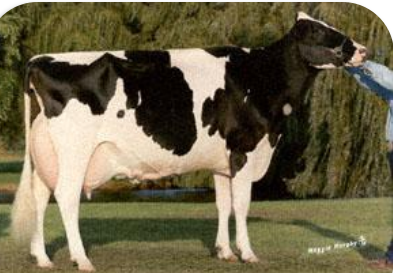
Jersey
Origin: Island of Jersey
Smallest of all the dairy breeds
Second most common breed in the U.S.
Known for their feed efficiency and high components of fat and protein
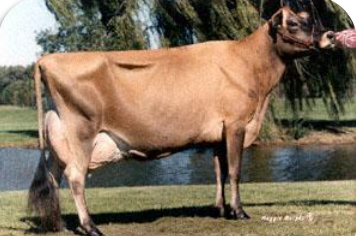
Brown Swiss
Origin: Switzerland
Colors can range from nearly white to very dark brown
Most resilient breed
High milk yield (lower fat content than Jerseys and Guernseys)

Guernsey
Origin: Island of Guernsey
A shade of fawn with white markings
Capable of producing milk with high fat and protein content
Golden Guernsey milk has a yellow tint from beta-carotene

Ayrshire
Origin: Ayr, Scotland
Color varies from light to deep cherry red, mahogany brown, or a combination of these colors with white, some are all white
Considered intermediate among all of the dairy breeds for milk production
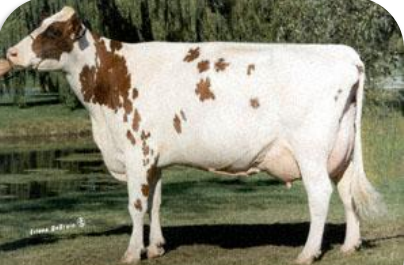
Milking shorthorn
Origin: Northeastern England in the Valley of the Tees River
Can range in colors from either red, red and white, white or roan
Most versatile of all breeds
Originally used for meat, later developed more for the milking industry
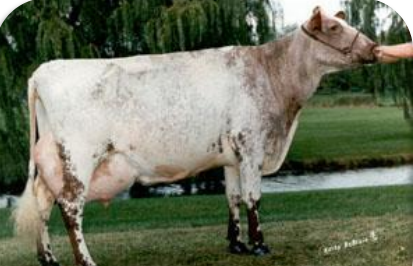
Herd side trends
Decreased from 23 million to 9.2 million in the US between 1935 and 2024
Due to efforts placed on improving genetics relating to milk yield, dairies do not need as many cows to sustain dairy demands
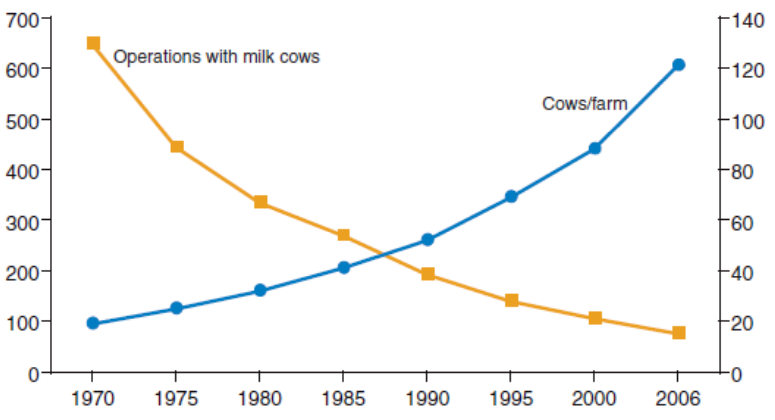
Where are the dairies located in the US
California, Wisconsin, Idaho, Texas, and New York
The majority of dairies are located around highly populated areas because milk is highly perishable
NC Dairy statistics
NC is part of the Southeast US milk deficit region
Most dairies in NC are family owned
Average herd size is 320 head and 500 acres
Ranks in the middle of the US states for milk production and cow population
Slightly below average milk output per cow
Global dairy production
dairy cows produce more than 80% of the worlds milk supply
The US is the leading producer in total milk and milk/cow efficiency
Management decisions are influenced by
Price, supply and demand trends for milk and dairy
products
Markets available for milk
Pricing structure and regulation of milk marketing
Price of milk
Influenced by consumption
Cows produce more milk in May and produce the least in November
Price of milk is the lowest in May and June
Price of milk is the highest in Oct, Nov, and Dec
How is milk utilized
Fluid Products: 29%
Manufactured Products: 71%
Hard Cheese: 43%
Butter and Nonfat Dry Milk: 15%
Soft Dairy Products: 12%
Class I product classification
Fluid: bottled milk, cultured buttermilk, eggnog
Class II product classification
Soft: Icecream, yogurt, cottage cheese, sour cream
Class III product classification
Cheese: Cheese, cream cheese
Class IV product classification
Butter/dry: Butter, nonfat dry milk
Pasteurization
Heating raw milk at a high enough temperature for a sufficient time to remove pathogens (bacteria) and increase shelf life. Has no effect on nutritional value.
Homogenization
Breaks up and disperses milk fat throughout the milk to prevent cream from rising to the top.
UHT milk
Heated to a higher temperature than pasteurized milk, stays fresher longer, has longer shelf life (up to 3 months) because milk is packaged in sterilized, air free packaging.
Fortification
98% of milk sold in the USA is fortified with Vitamins A and D. Some milk is also fortified with extra protein and extra calcium.
Dairy product consumption from 1960 to 2017
On the rise from the mid 1970s
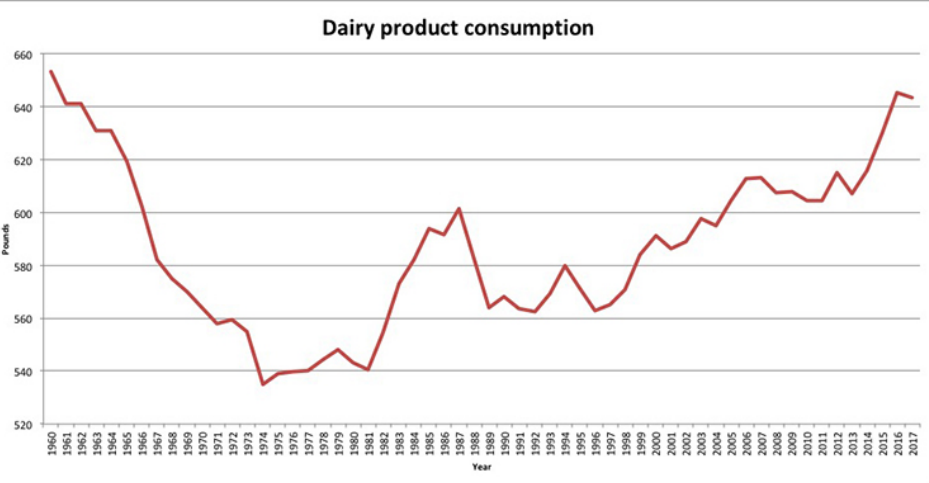
Whole milk
3.25% fat [contains 150 calories and 8 grams (g) of fat per serving (8 fluid oz)]
May be fortified with vitamin D at a level of 400 International Units (IU) per 1 quart
2% Reduced-Fat Milk
2% fat [contains 120 calories and 5 grams (g) of fat per serving(8 fluid oz)]
Vitamins A and D are removed with the milk fat. For this reason, these vitamins must be added to 2% reduced-fat milk so that it contains at least 2,000 IU of vitamin A and 400 IU of vitamin D per 1 quart.
1% Lowfat Milk
1% fat [contains 100 calories and 2.5 grams (g) of fat per serving (8 fluid oz)]
Vitamins A and D must be added to a level of at least 2,000 IU of vitamin A and 400 IU of vitamin D per 1quart.
Fat-Free Milk
0% fat [contains 80 calories and 0 grams (g) of fat per serving (8 fluid oz)]
Vitamins A and D must be added to a level of at least 2,000 IU of vitamin A and 400 IU of vitamin D per 1quart
Evaporated Milk
6.5% fat is made by removing about 60% of the water from whole milk.
The milk is then homogenized, fortified with vitamin D to a level of 25 IU per 1 fluid ounce, canned and heat sterilized.
Evaporated Fat-Free Milk
0.5% fat or less is a concentrated, fortified (vitamins A and D) fat-free (skim or nonfat) milk that is canned and sterilized
Sweetened Condensed Milk
8% fat or less is a canned milk concentrate of whole milk to which sugar has been added. The sweetener used (usually sucrose) prevents spoilage.
Sweetened condensed fat-free milk contains no more than 0.5% milk fat.
Per capita consumption of fluid milk products in the US from 2000 to 2021
Decreased
Butter and cheese consumption has risen
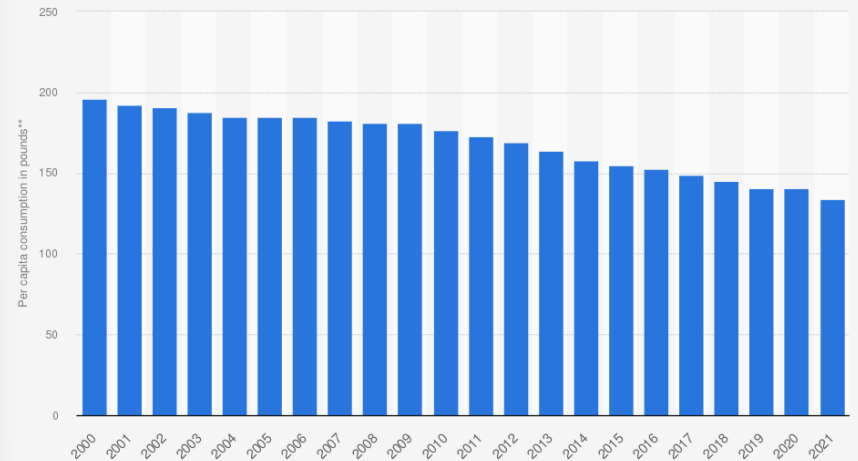
Butter
Must contain more than 80% fat and may contain some solids non fat (protein, minerals, etc) and water, the rest of the milk solids and water are used to produce non-fat dry milk and condensed skim milk
More products are produced when milk production is highest—surplus milk is used to make these products
Grade “A” Raw Milk
Must be cooled to 45 degrees F or less within 2 hours of milking
Blend temperature after the first and subsequent milking cannot exceed 50 degrees F
Each farmers milk cannot exceed 100,000 bacterial count per milliliter before it is mixed with other producers
Bacteria count from several producers cannot exceed 300,000 bacterial count/ mL before it is pasteurized
Each producers milk cannot exceed 750,000 somatic cells per milliliter
Can be no detectable antibiotics
Inspections on the farm are made regularly and the permit to sell Grade A milk can be suspended if violations are found and not corrected.
Grade B Milk
Produced under standards that allow it to be used for manufacturing of dairy products but not for fluid milk
Standards are not as strict as for Grade A milk
Grade B milk is safe and wholesome in manufactured products
Typical dairy herd for 100 milking cows
92 healthy cows
4 cows that have recently calved
4 cows with special needs
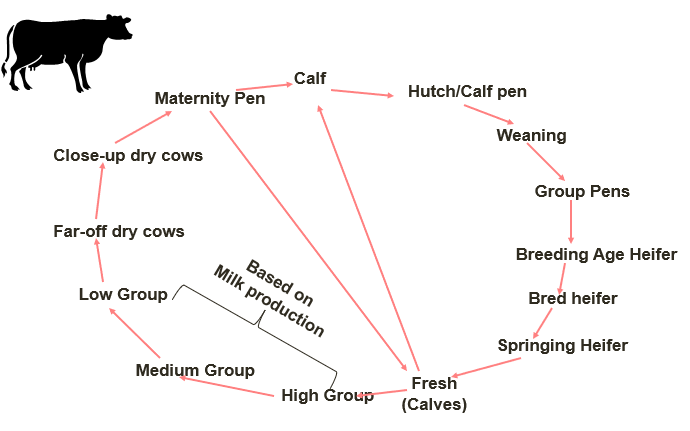
Calving
Year-round calving is most common in the US to promote a steady flow of milk for sale
Some seasonal calving utilized to reduce milking and calving in the coldest months or to support grazing-based systems
Gestation in cattle is approximately 282 days
Newborn Calf Management
Birth weight: 60-100 pounds
Colostrum feeding - hand feeding compared to beef nursing
Weaning from dam - within first day
Navel dipping
Identification
Calves
Should receive colostrum, via bottle, within an hour of birth
After colostrum, calves are fed reconstituted milk-replacer and until weaning (30-60 days of age)
Calves are raised in hutches or specialized calf facilities
Dairy (heifer) Replacements
Goal 1: first calf by 2 years of age
Selected females will be bred at about 15 months of age
After a heifer has a calf and enters milking herd, she’s often called a 1st calf heifer
Goal 2: 12 month calving intervals
Rebred by 90 days post-calving
Full maturity reached at about 4-5 years
12 Month Production Cycle
Lactation is initiated by calving
Standard lactation period: 305 days
Peak production reached at 45- 60 days
Dry period: 60 days
Cessation of milk production and rebuilding of body stores and mammary gland
Lactation is reinitiated by calving
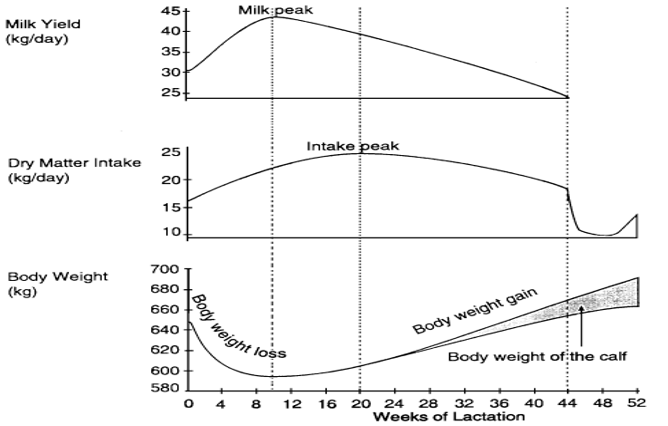
Early Lactation
14 – 100 days
Achieve peak (60 days for Holstein)
Milk yield increases more rapidly than dry matter intake
Mid- Lactation
100 – 200 days
Goal is to maintain peak milk productions as long as possible.
Late Lactation
200 days after calving and end when the cow dries off (day 305)
Cow gains weight to replenish body condition
What makes a great commercial dairy cow?
High milk yield, good components and feed efficiency
Avoids metabolic disorders and maintains body condition
Shows heat and conceives when bred
Stands and walks comfortably and hooves rarely need trimming
Has live calves without assistance
Resists mastitis and avoids injury
Stall Barns
One or two rows of cows in stanchions, tie stalls, or comfort stalls
Cows may be faced inward toward center of barn, or outward toward the wall
Time spent laying down is dramatically decreased in this stanchion barn with concrete stall platforms, reducing cow performance
Older facilities were not designed for cow comfort, but instead focused on worker comfort and cow cleanliness

Loose housing
Group hosing
Cows rest in common areas on a manure pack
About 60-70 sq ft per cow
Bedding should be deep and more should be added daily
Free-stall housing
Open individual stalls, bedded
Small breeds have different size stalls than large breed cows
Organic bedding
Saw dust
Newspaper
Chopped straw
Manure recycled solids
Compost
Advantages of organic bedding
Low initial investment
Cow comfort
Cow cleanliness
Disadvantages of organic bedding
Cost over time
Increased labor for maintenance
Problems for manure-handling systems
Sand advantages
Low initial investment
Cow comfort
Cow cleanliness
Sand disadvantages
Cost over time
Increased labor for maintenance
Problems for manure-handling systems
Mattresses advantages
Insulating
Good traction
Durable
Easy on manure-handling systems
Mattresses disadvantages
Expensive initial investment
Possible mattress hardening
Ventilation
Critical for cow productivity
Determined by amount of air changes needed for moisture removal\
Milking Frequency
2X milking (two times each day) is most common
3X produces 10-15% more per cow per day
Farms make this decision based on herd size/parlor size, feeding program, labor availability, etc.
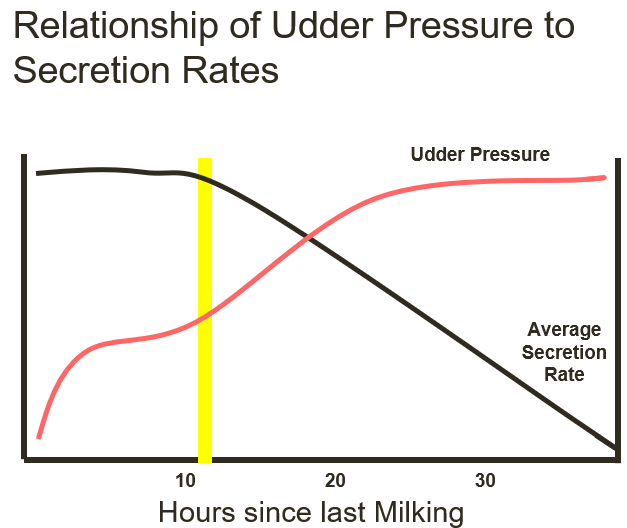
Milking Parlor Issues
Cost
Type and Size of parlor
Herd size & expansions
Labor available
Farm location/design/issues
Single Side opening
Handle cows one at a time so a slow-milking cow does not delay the completion of milking and release of other cows in the parlor.
These parlors are well suited to farms that take special care about observing individual cows and practice individual cow care in the parlor.
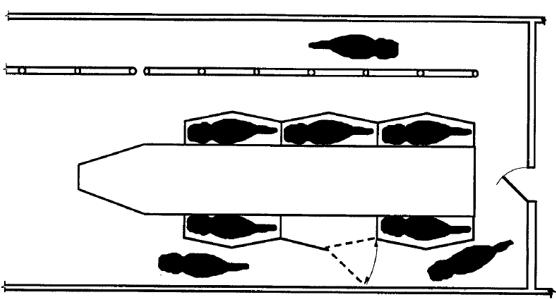
Herringbone
Most common parlor type in the US for ‘small’ parlors (less that double 12). Cows stand on an elevated platform in an angled or herringbone fashion facing away from the operator area
This exposes enough of the back half of the cow to allow access to milk her from the side and room for an arm type detacher and associated equipment.
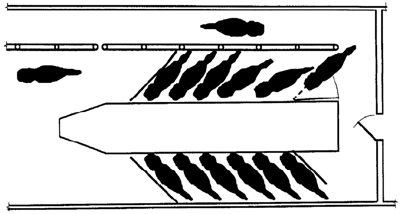
Parallel (Side by Side)
Cows stand on an elevated platform at a 90-degree angle facing away from the operator area.
Access to the udder is between the rear legs, which reduces visibility of the front quarters and can make unit attachment and udder user sanitation more difficult.
Most use rapid exit stall fronts and use dual return lanes. The stall spacing in this parlor type is such that support arms cannot be used. It is also more difficult to balance milking units on the udder in this parlor type.

Swing Over (Parabone)
The cows are placed at a greater angle from the operator (about 70 degrees) than in traditional herringbones but less than 90 degrees as in a parallel.
Procedures and equipment developed for milking between the hind legs are used. Milklines are typically mounted as “midlines” or above the head of the operator resulting in a lift from the udder to milk line of about 1 meter
The primary advantage is that fewer milking units are needed and stall designs are simper, both of which reduce the initial cast of the parlor. The main disadvantage is this parlor type is the inconvenience resulting from milk hoses hanging in the operator area and the inefficiencies resulting from switching unit from side to side (especially for a slow milking cow and/or cow requiring special attention. This parlor type is not suited to the use of support arms and automatic detachers are typically mounted above the milkline.

Rotary
Gaining in popularity
Platform on which the cows stand moves around
Milkers stand in one location
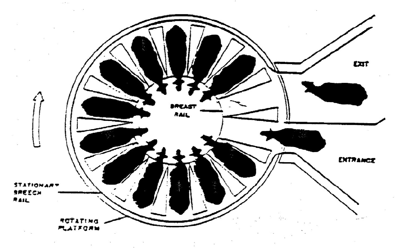
Milking Machine Goals
A properly designed, installed, maintained, and operated milking machine will:
Remove milk from the animal quickly and gently
Minimum irritation to the udder, teats, tissues
Support good udder health
Prevent invasion of organisms
Not degrade milk quality from the time of removal to delivery
Be easy to clean and sanitize
Milking Machine Components
Milking units
Vacuum production and control system
Milk transport system
Cleaning and sanitation systems
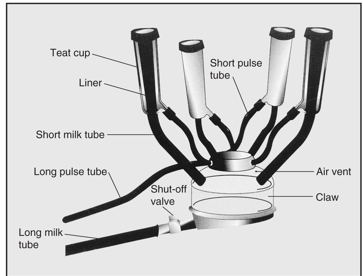
4 Teatcups
A soft rubber liner that is mounted in a metal or plastic shell
The soft rubber liner is the only part of the machine that touches the udder
The Claw
Collect milk from all of the teatcups
The Pulsator
An air valve that creates ‘pulsation’ or the opening and closing of the liner
Connecting tubes
Short milk tube = liner to claw
Long milk tube = claw to milkline
Short pulse tube = shell to air fork
Long pulse tube = air fork to pulsator
Pulsation ratio
% of time milk phase
% of time rest phase
Desirable 50:50 to 70:30
Pulsation rate
no. of cycles per minute - 50 - 60
How the milking machine gets milk out of a cow
Vacuum is applied to the inside of the liner to withdraw milk from each teat and keep the machine attached to the cow
Milking phase: When the pulsation chamber is under a vacuum, the liner is open and milk flow starts
Atmospheric pressure is the applied to the pulsation chamber and the liner closes.
Massage phase: Milk flow stops and the teat is massaged to reduce congestion
Mammary Gland Structure
Udder consists of four separate glands
A teat hangs from each quarter
Bottom of teat closed by sphincter muscle known as streak canal
Can have extra nonfunctional teats
Called supernumerary teats
Removed when calf is young
Teats should be moderately sized and located centrally on each quarter
Sphincter in each teat should be tight enough to prevent leakage
Teats are hairless
Support system
Stroma (connective tissue)
Parenchyma
Glandular; secreting tissue
Alveoli
secreting epithelial cells
the basic milk producing unit
Small bulb-shaped structure with hollow center
Lined with epithelial cells that secrete milk
surrounded by network of capillaries and myoepithelial cell
Contraction of myoepithelial cell stimulates milk ejection
Duct system
lined by epithelial cells
provide storage area for milk and a means for transporting it outside
Lined by two layers of epithelium
Myoepithelial cells are arranged in longitudinal pattern
Shorten to increase diameter to facilitate flow of milk
Lobules & lobes
clusters of alveolar tissue supported by connective tissue
Groups of alveoli empty into a duct
Ducts of lobe empty into a galatophore, which empties into the gland cistern
Mammary Gland Structure/Suspension
3 major supporting structures: Skin, Median suspensory ligament, Lateral suspensory ligament
Intermammary groove formed where lateral suspensory ligament and median suspensory ligament meets
Skin
Minor role in support
Median suspensory ligament
Separates right and left halves of udder
Connects udder to abdominal wall: Lamellae
Elastic tissue which responds to weight of milk in udder
Lateral suspensory ligament
Inflexible
Surround the outer wall of udder
Attached to prepubic and subpubic tendons
Streak canal
Functions to keep milk in udder and bacteria out of udder
Teat cistern
Duct in teat with capacity of 30-45 milliliters
Separated from streak canal by folds of tissue called Furstenberg’s rosettes
Gland cistern
Separated from teat cistern by the cricoid fold
Holds up to 400 milliliters of milk
Collecting area for the mammary ducts
From this branches the mammary ducts
Myoepithelial cells
Contract to force out milk – oxytocin
Capillary ducts to milk ducts to gland cistern
Epithelial cells
milk synthesis & secretion
Lumen
collect milk components & water
Basement membrane
selective transfer
Terminal duct
milk transport out of alveoli
Capillary system
supply milk precursors and deliver hormones
Lactogenesis
Process by which mammary alveolar cells acquire the ability to secrete milk
Galactopoiesis
Maintenance of actual production/ synthesis of the milk
Agalactia
Absence of milk production
Due to low Prolactin
What stimulates the milk letdown response
Sight
Sound
Smell
Routine
Direct nerve stimulation
Teat washing
Suckling
Circulation
One gallon of milk requires 400 gallons of blood being passed through udder
Ratio may increase in low producing cows
Blood enters the udder through external pudic arteries
Blood exiting udder from veins at the base of udder blood can travel through two routes
Via external pubic veins
Via subcutaneous abdominal veins
Lymphatic System
Helps regulate proper fluid balance within udder and combat infection
Fluid drained from tissue only travels away from udder
Blood capillary pressure
Contraction of muscles surrounding the lymph vessels
Valves that prevent backflow of lymph
Mechanical action of breathing
Lymph travels from udder to the thoracic duct and empties into blood system
Flow rates of lymph depend on physiological status of the cow
Edema
low pressure, passive system fed by a high pressure vascular system!
this situation results in pooling of interstitial fluid if evacuation of lymph is impaired
Frequent milkout to reduce mammary pressure
Diuretics, corticoids to reduce swelling
Quality of raw milk for cheese manufacture
Is largely defined by: Milk composition, Microbial activity of milk, Somatic cell count (SCC), Enzymatic activity of milk, Chemical residues
Somatic Cell Counts (SCC)
Released from the blood to combat udder infection, and thereby, prevent or reduce inflammation (mstitis)
Factors that contribute to increases in SCC of milk include: sub-clinical mastitis, advance in stage of lactation, lactation number, stress and poor nutrition.
Standard Plate Count (SPC)
Measure the bacteria content of raw milk.
the Raw count, the Standard Plate Count (SPC)
Determines the total number of bacteria in a milk sample that can grow and form countable colony forming units on a Standard Methods Agar plate
1 ml of milk added to plate
Then incubated aerobically at 90°F for 48 hours
Raw milk should contain less than 5,000 bacteria/ml.
a SPC of 10,000/ml or less should be achievable by most farms.
The maximum legal limit for SPC is 100,000 bacteria/ml
Preliminary Incubation Counts (PIC)
The PI count is based on the theory that the normal microbial flora of the cow will not grow very well when incubated at this combination of time and temperature.
To determine PI, a sample of milk is incubated for 18 hours at 55°F followed by the SPC procedure.
Microorganisms called psychrotrophs or cold-loving bacteria
Psychotrophic bacteria will continue to grow at temperatures below 45o F.
These organisms and the enzymes they produce are associated with off-flavors, milk spoiling and short shelf-life.
Currently there is not a legal limit for PIC.
A PIC above 20,000 cfu/mL is considered a high level.
Many herds can have a PIC of 10,000 or less just like the SPC if sanitation, cooling and milk procedures are done properly and monitored.
Causes of High Bacteria Counts
Improper cleaning of milking equipment after each milking or neglecting to sanitize equipment before the next milking
Wash water temperature should start at 155-170°F and drain at above 120°F
Using the wrong amount or type of detergent, acid or sanitizer.
Gaskets, teatcup liners, rubber parts and hoses need to be clean, free of cracks and deposits and replaced when needed.
Check your bulk tank cooling system. Slow cooling bulk tank or temperature above 40°F. The bulk tank milk temperature should be less than 40°F within two hours of milking and kept below 45°F during milkings.
Mastitis infections due to Streptococcus agalactiae can lead to a large number of these bacteria being released in the milk. Several cows infected with Strep. Ag. can cause the bulk tank SPC to be elevated